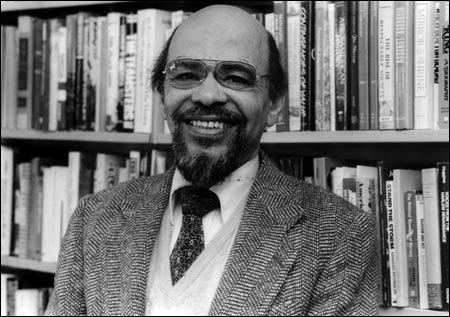Adding some color to Harvard portraits:
Project aims to give a face to accomplishment

They look down on us from their gilded frames, the illustrious scholars and benefactors of Harvard’s past, representatives from each of the four centuries of the University’s existence, from the earliest progenitors in their powdered wigs and lace collars to 20th century figures in their business suits and ties.
And they are everywhere – in administrative offices, lobbies, meeting rooms, libraries, museums, undergraduate houses, and dining halls – lending their countenances to the school’s collective identity.
But who are these people? Taken as a group, what do they represent? Last year a group of students decided to find out. They conducted a survey of Harvard portaits. The results? Of the 302 portraits gracing the walls of the University, only three were of persons of color.
The students reported these results to S. Allen Counter, director of the Harvard Foundation, the group that seeks to improve racial and ethnic relations within the University. Counter went to President Lawrence H. Summers with the results.
Summers came up with $100,000 to support the foundation’s Minority Portraiture Project. A committee of faculty and students has been formed to select the subjects of the first group of portraits.
‘These portraits will include persons of African-American, Asian-American, Latino-American, and Native American backgrounds who have served Harvard with distinction, and whom the committee believes worthy of such recognition.’
– S. Allen Counter, Director of the Harvard Foundation
“These portraits will include persons of African-American, Asian-American, Latino-American, and Native American backgrounds who have served Harvard with distinction, and whom the committee believes worthy of such recognition,” said Counter. “The portraits will be placed at sites of significance around the Harvard campus including the Faculty Room, the Harvard houses, and libraries.”
The Rev. Professor Peter J. Gomes, Pusey Minister in the Memorial Church and Plummer Professor of Christian Morals, serves as chair of the committee, and Counter serves as coordinator.
Other committee members are Ali Asani, professor of the practice of Indo-Muslim languages and culture; David L. Evans, senior admissions officer for Harvard College; Sandra Grindlay, curator of the Harvard University portrait collection; Sarah Lawrence-Lightfoot, the Emily Hargroves Fisher Professor of Education; Sandra Naddaff, professor of literature and master of Mather House; Pedro Noguera, the Judith K. Dimon Professor in Communities and Schools; Naomi Pierce, professor of biology; Melissa Luna ’03; and Ethan Yeh ’03.
At the foundation’s most recent meeting it was decided that the committee would commission a portrait of the late Nathan Huggins, who served as the W.E.B. Du Bois Professor of History and Afro-American Studies and as director of the Du Bois Institute from 1980 until his death in 1989. The portrait will be placed in the Faculty Room of the Faculty of Arts and Sciences in University Hall.
Other names recommended by the Committee are: the late Ewart Guinier, professor of Afro-American studies and department chair, 1969-76; Karel Liem, professor of biology and former master of Dunster House; the late John Monro, former dean of Harvard College who spearheaded an effort to recruit poor and minority students; Rulan Pian, professor of East Asian languages and civilizations and of music emerita and former master of South House; the late Annemarie Schimmel, professor emerita of Indo-Muslim culture; and the late Eileen Southern, professor of Afro-American studies and of music, chair of the Afro-American Studies Department, 1975-79, and the first black female professor tenured at Harvard.
According to Counter, the subjects of the portraits commissioned by the committee will be predominantly, but not exclusively, persons of color.
The committee has also agreed to host a major exhibition in the fall of 2003 of photographic portraits of minority faculty and administrators who have served Harvard with distinction for many years.




